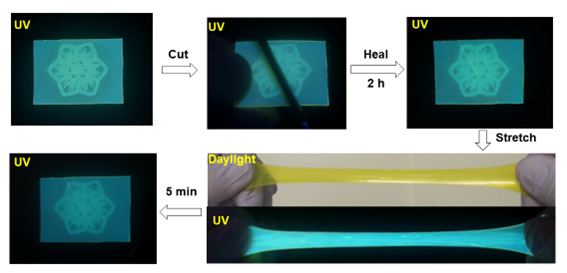Feb. 26, 2024 Press Release Chemistry Engineering
Bright and tough: A material that heals itself and glows
A research team at the RIKEN Center for Sustainable Resource Science (CSRS) has succeeded in developing a self-healing material that is also capable of emitting a high amount of fluorescence when absorbing light. The research, published in the Journal of the American Chemical Society, could lead the way to the creation of new materials such as organic solar cells that are more durable than current types.
In 2019, Zhaomin Hou and his team at RIKEN CSRS successfully copolymerized ethylene and anisylpropylene using a rare-earth metal catalyst. The resulting binary copolymer displayed remarkable self-healing properties against damage. The copolymer's soft components, alternating units of ethylene and anisylpropylene, coupled with hard crystalline units of ethylene-ethylene chains, acted as physical cross-linking points, forming a nano-phase-separated structure that proved crucial for self-healing.
Building upon this success, they incorporated a luminescent unit, styrylpyrene, into a monomer and then formed polymers that also included anisylpropylene and ethylene. This process led to the synthesis, in a single step, of a self-healing material with fluorescence characteristics.
“Fluorescent materials are very useful, as they can be used for organic light emitting diodes (OLEDs), organic field-effect transistors (OFETs), and solar cells. One of the main problems of these materials, however, is their short lifetime during usage. Our new material can be expected to afford longer lifetime of the products and increased reliability,” says Masayoshi Nishiura, Hou’s collaborator for this study.
There was an added surprise. The resulting copolymer not only proved to be tough, but also exhibited self-healing without external stimuli or energy. Its tensile strength fully recovered within 24 hours, demonstrating a high self-healing speed compared to binary copolymers. The material was able to self-heal even in water, acidic, and alkaline solutions giving it potential uses in a variety of environments.
The copolymer's network structure, which involves physical cross-linking points formed by the styrylpyrene units and crystalline ethylene-ethylene nanodomains and soft segments composed of the alternating units, facilitated the self-repair.
The material also showed an added property. The research team was able to successfully transfer a two-dimensional image onto the fluorescent self-healing film through photolithography. Although the image remained invisible under natural light, it became recognizable under ultraviolet light, suggesting potential applications for the film as an information storage device. The film maintained its excellent self-healing and elastomeric properties even with the images.
“The material we synthesized, through a one-step reaction, gave us the ability to control its optical and mechanical properties by adjusting the composition of the monomer. We think it could contribute significantly to the development of novel functional materials with high self-healing capabilities in various practical environments,” says Hou. This research aligns with the United Nations' Sustainable Development Goals (SDGs), particularly contributing to "Goal 12: Ensure sustainable consumption and production patterns."
Rate this article
Reference
Contact
Zhaomin Hou
Advanced Catalysis Research Group
RIKEN Center for Sustainable Resource Science
&
Organometallic Chemistry Laboratory
RIKEN Cluster for Pioneering Research
Masataka Sasabe
RIKEN International Affairs Division
Tel: +81-(0)48-462-1225
Email: masataka.sasabe [at] riken.jp

Fluorescence and self-healing property of the flower-printed film of terpolymer composed of ethylene, anisylpropylene, and pyrenylethenyl-substituted styrene.
